The Legacy of Masjid Al-Haram and the Zamzam Well

As Muslims from all over the world step onto the sacred grounds of Makkah, they are greeted by two of Islam’s most important landmarks: Masjid Al-Haram and the Zamzam Well. These revered symbols don’t just stand as testament to the profound spirituality of Makkah, but also echo rich histories and modern initiatives that enhance their magnificence and accessibility to pilgrims worldwide.
Masjid Al-Haram: A Sanctuary Through Millennia
The divine legacy of Masjid Al-Haram commences well before the era of Prophet Muhammad (PBUH). The Kaaba, enveloped by the Masjid, was constructed by Prophet Ibrahim (PBUH) and his son, Prophet Isma’il (PBUH), guided by divine revelations from Allah. A sanctuary proclaimed to be the holiest site in Islam, this mosque has witnessed centuries of prayers, renovations, and expansions along the way.
From its modest inception, Masjid Al-Haram underwent numerous expansions, accommodating the ever-growing influx of believers and pilgrims. Each Islamic dynasty, from the Umayyads to the Ottomans, endowed their own architectural and aesthetic enhancements, making it the magnificent structure we witness today, able to host millions of pilgrims simultaneously.
In 2015, King Salman bin Abdulaziz Al Saud introduced five major projects aimed at enlarging the mosque’s capacity, enabling it to host nearly 2 million worshippers within a 1.5-million-square-meter area. Masjid Al Haram, along with its open areas and facilities, now stretches over an impressive 750,000 square meters, with an investment exceeding SR80 billion ($21.3 billion).
Today, the government of Saudi Arabia remains invested in further enhancing the capacity, facilities, and safety of Masjid Al-Haram. The most recent expansions and renovations aim to increase capacity, facilitate smooth mobility, and introduce technologically advanced systems to ensure safety and comfort for the pilgrims.
The Zamzam Well: A Miracle in the Desert
The Zamzam Well is synonymous with the unwavering faith of Hajar (PBUH), who, left in the desert with her son Isma’il (PBUH), placed her absolute trust in Allah. Her desperate search for water across the hills of Safa and Marwah was rewarded with the miraculous appearance of the Zamzam Well, which has continued to quench the thirst of pilgrims throughout the centuries since its divine emergence.
The water of the Zamzam Well is said to possess unique qualities; it is believed to be a source of both physical and spiritual nourishment and fulfillment. Zamzam water is notably mineral-rich, contributing to its stable health properties, including its taste and odor, which have remained consistent over time. It contains four essential metal ions: sodium, potassium, magnesium, and calcium, all of which are present in substantial amounts.
Zamzam water also features seven trace metal ions: vanadium, manganese, iron, cobalt, copper, zinc, and molybdenum. These trace metals are recognized for their essential role in maintaining normal biological functions in humans, underscoring the water’s nourishing characteristics beyond its spiritual significance. This composition not only aids in physical well-being but also maintains the water’s characteristic taste and purity even as it is transported from its source to worshippers worldwide.
The government of Saudi Arabia undertakes extensive measures to preserve the quality and availability of the Zamzam water. Sophisticated systems are installed to pump, treat, and distribute the water, ensuring it remains a pure and plentiful source for pilgrims. Multiple kiosks and distribution points are established throughout the holy mosques to facilitate easy access to this blessed water.
In 2022, Saudi authorities took things up a notch by deploying specialized robots for the distribution of Zamzam water to visitors at the Two Holy Mosques in Makkah and Madinah. The initiative, introduced by the General Presidency for the Affairs of the Two Holy Mosques, aligns with the ongoing efforts to enhance both the spiritual and technological experience of pilgrims.
Authorities continue to develop innovative and convenient methods for providing Zamzam water to pilgrims, including a plan to install automatic filling stations, using smart technology to measure water levels and temperatures, as well as continuing to study ways to use robots and artificial intelligence to distribute Zamzam water bottles to pilgrims effectively and efficiently.
Witness the grandeur of Masjid Al Haram first-hand, and sip Zamzam water straight from the source, when you book your Umrah package with Umrahme. Focus more on the journey and less on the preparation. Let us take you there.








